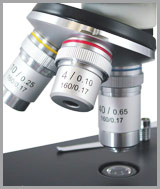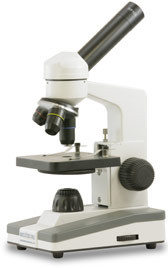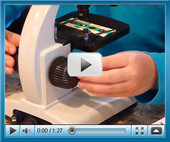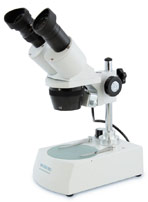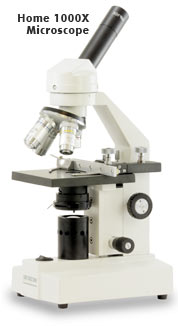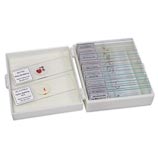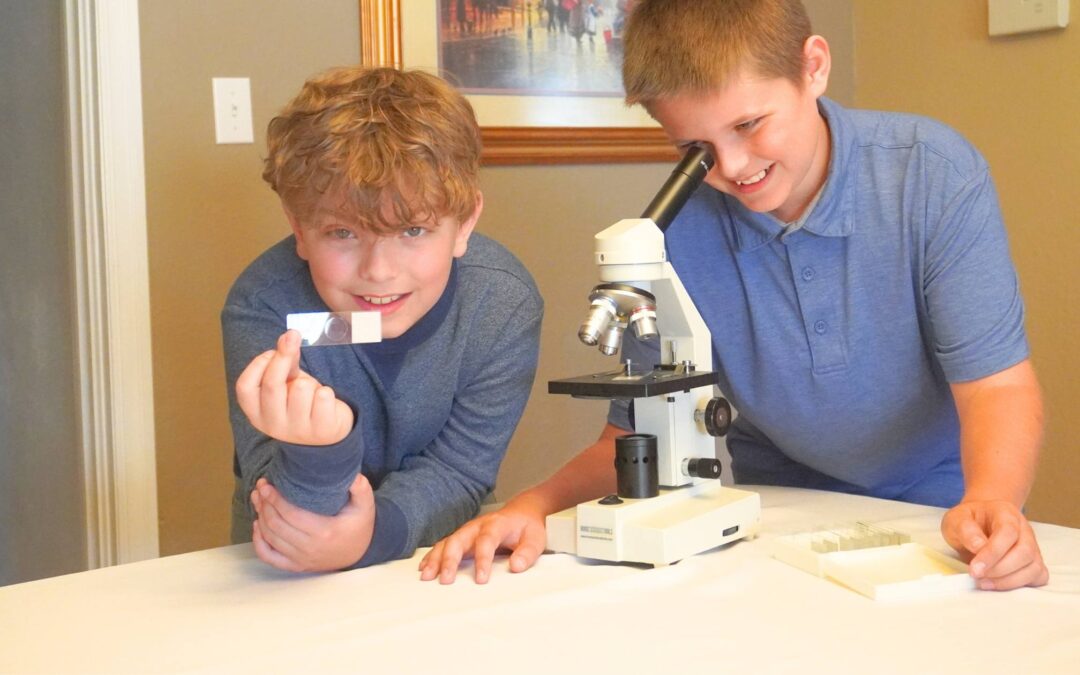| There are two basic types of microscopes: compound and stereo.
Click on any of the following links to find out more! This page is printer-friendly. |
|
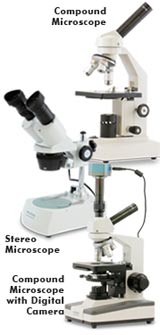
|
|
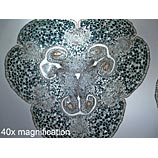
How to Choose a Compound MicroscopeFinding just the right compound microscope depends on your needs and preferences. Read on for more information! Need tips on how to choose a microscope? Answer these three questions: – Is standard 400x magnification enough, or do you want 1000x magnification to see greater cell detail? 400x is ideal for high school biology; 1000x is best for college microbiology. – Do you want a mechanical stage for precise slide control? It’s not necessary, but it makes viewing slides easier. 1000x microscopes should have a mechanical stage built in; you can add it to most other microscopes. – Do you need to be able to focus in on a slide to see every detail clearly? Some microscopes only have coarse adjustment, meaning you can focus generally on a detail but can’t get as sharp a view as with coarse and fine focus together. Any compound microscope used for high school level and up should have a fine focus adjustment! Keep these features in mind to help you decide on the best microscope option to meet your needs. The microscopes that Home Science Tools sells have quality glass optics. (Plastic optics, like those on most toy microscopes, produce blurry images.) They also have sturdy metal frames. These are standard features; we don’t recommend settling for anything less!
About 400x Compound Microscopes:
Customers consistently rate it with five stars (you can read their reviews on the product page). This full-size compound microscope is easy to use and provides large, clear images that will meet your needs for high school biology. It has standard magnification levels of 40x, 100x, and 400x and lenses that are achromatic, parcentered, and parfocaled, meaning they prevent image color distortion and keep a slide in focus even when you change magnification levels. The Home microscope is pre-drilled for a mechanical stage if you decide to add one. (This provides more precise slide control.) For a printable guide to the Home Microscope’s features, click here. If you’re looking for something more specialized but still at a low price, the Home Advanced LED Microscope has an adjustable 1.25 Abbe condenser and iris diaphragm to provide better image contrast. It comes with a mechanical stage, too. All of our Home Microscopes have a lifetime warranty. We recommend them for all ages! Choosing Kids’ Microscopes:
You can get glass optics and precision mechanics with at least intermediate focusing (a cross between coarse and fine) for a comparable price to a cheaply-made toy microscope. Our Kids LED cordless microscope is a popular lower-cost option for the elementary grades. Our line of Kids microscopes do have smaller optics and only intermediate focus mechanisms, so the image they produce is not quite as sharp as our better microscopes, but they’re a very child-friendly option that will provide years of use and are a fantastic introduction to the world of microscopes. The LED lighting is bright and cool and the bulb should last 100,000 hours—a lifetime of normal use! We recommend Kids microscopes for ages 5-13, as the optics do not provide the clear detail necessary for some high school biology work.
Or, for a printable guide to the Kids Microscope’s features, click here. About 1000x Microscopes:You’ll be able to see greater specimen detail with a 1000x microscope (10x eyepiece lens with 100x objective lens), but generally it’s only essential if you’re doing a microbiology course or using it in a laboratory. If you love the idea of being able to look close up at almost anything, though, it’s also a good choice. Our Home 1000x LED compound microscope provides a 100x oil-immersion objective lens and has features like an adjustable iris diaphragm for excellent contrast control and an integral mechanical stage for precise slide scanning. You can order it with a binocular head for extra-comfortable viewing, or with a dual head for simultaneous teacher/student use and for video & digital photography. Although this level of quality and features is not necessary for high school, these microscopes are great for those who have a strong interest in microbiology or for those who want to pursue a career in medicine.
|
How to Choose a Stereo or Dissecting Microscope |
|
| Stereo and dissecting microscopes are excellent tools for exploring natural wonders.
Stereo microscopes are designed for viewing whole objects such as minerals, insects, stamps, and coins, although they can also be used to view slides at low power. They have lower magnification power than compound microscopes – usually 20x or 30x, which is enough to view crystals, a dragonfly wings, flower petals, or whatever else you can discover. The two eyepieces of a stereo microscope provide greater depth perception than a compound microscope does, giving you a three-dimensional view.
If you’re looking for a zoom stereo microscope, the 7.5x-45x Stereo Zoom microscope from National Optical is the best we’ve found. It provides magnification from 7.5 to 45x (and every point in between) just by rotating the objective turret. This model has both top and bottom lighting and a 80 mm working distance with 110 mm maximum specimen height. Its binocular head makes viewing extra-comfortable. Use for grade 7 & up. How to Choose a Microscope for Your Homeschool or Classroom
We’ve added our own line of family-friendly compound microscopes designed specifically to meet your needs in both quality and budget. The Home microscope has 40x, 100x, and 400x magnification and fine and coarse focusing. Its optics provide large, clear images. It uses bright, cool LED lighting for extended use or viewing of live specimens, and is pre-drilled for a mechanical stage to provide more precise control of slide movement. The quality optics and magnification on this and the others in the Home series will meet your needs through high school!
The Home 1000x microscope allows you to get a close-up view of cells without having to buy an expensive lab microscope. It has a oil-immersion 100x objective lens for 1000x magnification and a built-in mechanical stage for precise slide control. This is a good choice if you plan on studying microbiology. How to Select a Digital Microscope or CameraA digital microscope is a great tool for both group and individual microscopy. You can use it to save, edit, and share still and video images of specimens, making this a great microscope for a homeschool co-op or other classroom! Display the magnified images on your computer, project them onto a screen, and send them by e-mail. Imaging software lets you zoom, count cells, create reports, and more. If you already have a regular microscope, we also offer digital cameras that have most of these special features. Our eFlex Digital Handheld Microscope is a handheld digital camera microscope with a 1.9-megapixel camera and 75x – 300x magnification that produces an image resolution up to 1600 x 1200 pixels! This portable microscope is an excellent gift for all ages. The entire family can view the LED images that you or your student captures with this unique microscope by connecting the included USB cable to their home computers. For a better camera, we offer a 2.0 Megapixel Digital Microscope Camera that produces 1920 x 1080 pixel images at up to 30 frames per second, as well as a 5.0 Megapixel Microscope Camera that produces 2560 x 1920 pixel images at up to 30 frames per second. Microscope Slides
Check out our tips for making slides and doing other activities with your microscope. |
|

